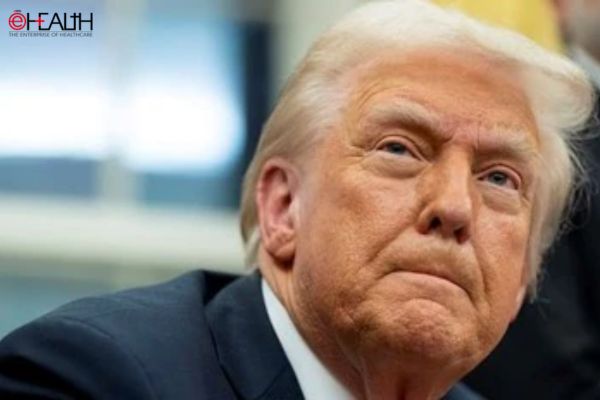
In a significant policy shift that could reshape the global pharmaceutical pricing landscape, former U.S. President Donald Trump has signed an Executive Order mandating that American consumers receive the lowest available global prices for prescription drugs. The directive, effective immediately, gives pharmaceutical companies 30 days to align their U.S. prices with the lowest international benchmarks, or face regulatory and enforcement actions.
Under this order, titled “Delivering Most-Favoured-Nation Prescription Drug Pricing to American Patients,” the U.S. Department of Health and Human Services (HHS), under Secretary Robert F. Kennedy Jr., has been tasked with negotiating reduced prices directly with pharmaceutical manufacturers. If negotiations fail, the administration has pledged to impose aggressive countermeasures, including rulemaking, importation approvals, antitrust enforcement, and export restrictions.

“The era of subsidising foreign health systems at the expense of American patients is over,” Trump declared, vowing to challenge what he referred to as “global freeloading” and “price discrimination” against American consumers.

What This Means for Indian Pharmaceutical Industry Leaders
India, as a leading global hub for affordable generic drug manufacturing and a key exporter to regulated markets like the U.S., will likely experience ripple effects from this bold policy move. While the directive primarily targets U.S.-based pricing, the broader policy mechanisms may influence sourcing costs, export pricing structures, and bilateral trade dynamics.

Key implications include:

- Upward Pressure on Export Prices:
Indian pharma companies exporting to the U.S. may need to reassess their pricing models, especially if the U.S. demands price parity with low-cost European markets. This could lead to reduced profit margins or revised pricing negotiations with U.S. buyers.
- Potential Drug Price Inflation in India:
As manufacturers compensate for price suppression in the U.S., India may face higher prices for imported patented drugs from American and multinational pharma giants.
- Shifting Global Trade Dynamics:
The order encourages drug manufacturers to explore direct-to-consumer sales in the U.S. at reduced rates. This could alter the traditional supply chain, impacting Indian contract manufacturers and third-party suppliers.
- Legal and Regulatory Uncertainty:
The directive hints at potential legal battles and retaliatory trade reviews, which may delay or complicate ongoing business between Indian firms and U.S.-based stakeholders.
- Call for Indian Industry Realignment:
Indian pharma leaders and policymakers may need to initiate dialogues with U.S. regulators and buyers to ensure continuity in exports and minimise operational shocks.
Indian Pharmaceutical Industry Speaks
“This Executive Order is a significant step in addressing the disparity in drug prices globally, which will be highly advantageous to Indian consumers and pharmacy networks like DavaIndia. As a leader in generic medicine retail with over 1500 stores and 1.5 crore happy customers, we are excited about this new stance on most-affordable-nation drug pricing. Data shows that American consumers pay about 3 times more than medical consumers in other developed countries for the same drugs. Should manufacturers voluntarily comply with a globally fair methodology for drug pricing, it will not only correct disparate pricing but will also quell lurking pressure on costs up and down the pharmaceutical supply chain.
For a country like India, where over 65% of healthcare spending is out-of-pocket, this measure enhances the issue of affordability of drugs, particularly if global transparency regarding pricing further pushes multinationals to model pricing corresponding with affordability. DavaIndia believes every Indian should have access to affordable, high-quality medication and this new resolution fortifies our very mission, and validates the model of value-based healthcare we have been advancing since the beginning.”
– Dr. Sujit Paul, Group CEO of Zota Healthcare Ltd
“The pharmaceutical industry faces a dynamic landscape with both significant opportunities and pressing challenges. On the opportunity side, there is increased demand for generic drugs, accounting for 35% of the U.S. supply, along with strengthened Medicare supply chains and enhanced global competitiveness. However, the industry must also navigate challenges such as pricing pressures that erode profit margins, the potential imposition of U.S. tariffs, stricter regulations around active pharmaceutical ingredient (API) sourcing, and a decline in R&D investment. In response, strategic actions include diversifying markets, investing in U.S.-based manufacturing, boosting API self-sufficiency, focusing on value-added products, and engaging in proactive policy advocacy.
The recent directive from the former U.S. President, Donald Trump, mandating domestic drug manufacturers to offer the lowest pricing to U.S. consumers, signals a potential shift in global pharmaceutical dynamics. While India’s $9 billion pharma export industry, supplying around 35% of U.S. prescriptions with cost-effective generics, remains relatively insulated for now, ripple effects are possible. The policy primarily targets high-cost branded and innovative medicines, but downward pressure on prices could extend to generics, especially in less competitive segments. Indian manufacturers, already operating on tight margins, may feel the squeeze. Additionally, the threat of unprecedented U.S. import tariffs looms, posing a risk to export viability.
In this evolving landscape, Indian pharma players must strengthen their strategic posture by diversifying markets, enhancing API self-reliance, investing in U.S.-based manufacturing, and advocating for balanced trade policies to safeguard competitiveness and ensure long-term growth.”
–Sandeep Jain, Founder & Managing Director, Akums Drugs & Pharmaceuticals Limited
Also Read :- Guarding Sensitive Data in Clinical Trials: Regulatory and Ethical Mandates in India
Call to Action for Indian Healthcare Stakeholders
Industry veterans, including exporters, formulators, and government policymakers, must closely monitor the next 30 days of negotiations between U.S. regulators and global pharma companies. India may need to strategically engage through trade missions, regulatory advocacy, and policy recalibrations to protect the interests of its $50 billion+ pharmaceutical industry.
Healthcare leaders must also prepare for potential price fluctuations in India’s domestic drug markets, particularly for U.S.-origin products, which could impact hospital procurement, pharmacy chains, and patient affordability.
Be a part of Elets Collaborative Initiatives. Join Us for Upcoming Events and explore business opportunities. Like us on Facebook , connect with us on LinkedIn and follow us on Twitter , Instagram.
"Exciting news! Elets technomedia is now on WhatsApp Channels Subscribe today by clicking the link and stay updated with the latest insights!" Click here!
















